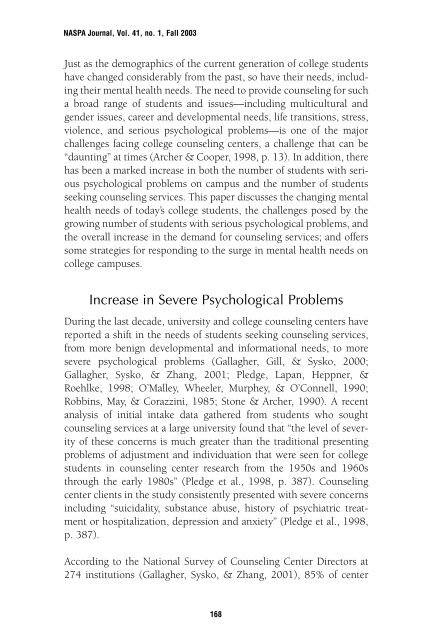mental health- counseling-1.pdf - iSites - Harvard University
mental health- counseling-1.pdf - iSites - Harvard University
mental health- counseling-1.pdf - iSites - Harvard University
You also want an ePaper? Increase the reach of your titles
YUMPU automatically turns print PDFs into web optimized ePapers that Google loves.
NASPA Journal, Vol. 41, no. 1, Fall 2003<br />
Just as the demographics of the current generation of college students<br />
have changed considerably from the past, so have their needs, including<br />
their <strong>mental</strong> <strong>health</strong> needs. The need to provide <strong>counseling</strong> for such<br />
a broad range of students and issues—including multicultural and<br />
gender issues, career and develop<strong>mental</strong> needs, life transitions, stress,<br />
violence, and serious psychological problems—is one of the major<br />
challenges facing college <strong>counseling</strong> centers, a challenge that can be<br />
“daunting” at times (Archer & Cooper, 1998, p. 13). In addition, there<br />
has been a marked increase in both the number of students with serious<br />
psychological problems on campus and the number of students<br />
seeking <strong>counseling</strong> services. This paper discusses the changing <strong>mental</strong><br />
<strong>health</strong> needs of today’s college students, the challenges posed by the<br />
growing number of students with serious psychological problems, and<br />
the overall increase in the demand for <strong>counseling</strong> services; and offers<br />
some strategies for responding to the surge in <strong>mental</strong> <strong>health</strong> needs on<br />
college campuses.<br />
Increase in Severe Psychological Problems<br />
During the last decade, university and college <strong>counseling</strong> centers have<br />
reported a shift in the needs of students seeking <strong>counseling</strong> services,<br />
from more benign develop<strong>mental</strong> and informational needs, to more<br />
severe psychological problems (Gallagher, Gill, & Sysko, 2000;<br />
Gallagher, Sysko, & Zhang, 2001; Pledge, Lapan, Heppner, &<br />
Roehlke, 1998; O’Malley, Wheeler, Murphey, & O’Connell, 1990;<br />
Robbins, May, & Corazzini, 1985; Stone & Archer, 1990). A recent<br />
analysis of initial intake data gathered from students who sought<br />
<strong>counseling</strong> services at a large university found that “the level of severity<br />
of these concerns is much greater than the traditional presenting<br />
problems of adjustment and individuation that were seen for college<br />
students in <strong>counseling</strong> center research from the 1950s and 1960s<br />
through the early 1980s” (Pledge et al., 1998, p. 387). Counseling<br />
center clients in the study consistently presented with severe concerns<br />
including “suicidality, substance abuse, history of psychiatric treatment<br />
or hospitalization, depression and anxiety” (Pledge et al., 1998,<br />
p. 387).<br />
According to the National Survey of Counseling Center Directors at<br />
274 institutions (Gallagher, Sysko, & Zhang, 2001), 85% of center<br />
168

















